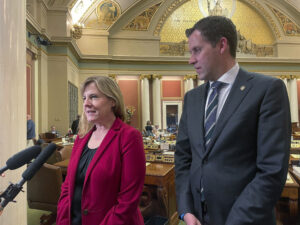California Trial Places Mortgage Blame on Bankers
In an "unprecedented" trial that challenges the Obama administration's official position on who was responsible for the 2008 financial meltdown, a Sacramento jury in late August thwarted a federal prosecutor's effort to charge borrowers with mortgage fraud after the defense successfully argued that executives who signed off on the loans didn't care whether answers given on mortgage applications were accurate.
In an “unprecedented” trial that challenges the Obama administration’s official position on who was responsible for the 2008 financial meltdown, a Sacramento jury in late August thwarted a federal prosecutor’s effort to charge borrowers with mortgage fraud after the defense successfully argued that executives who signed off on the loans didn’t care whether answers given on mortgage applications were accurate.
The Sacramento Bee reported last month:
[F]our people charged with mortgage fraud were acquitted Friday [Aug. 22] by a jury in Sacramento federal court after defense attorneys argued the real culprits are the so-called “victim lenders.”
According to experts, it is the first time in such a trial that a court has allowed the defense to present evidence that lenders ignored gaping holes and blatant lies in loan applications during the years leading up to the economic meltdown.
In his column at Salon.com on Sunday, political economy writer and cultural satirist Thomas Frank explained that President Obama’s Justice Department has shown “virtually no interest in holding leading bankers accountable for what went on in the last decade,” letting their response to the fallout of the crisis be guided by the logic that banking executives “could not have committed fraud” because “you would expect fraud to result in riches” when “so many banks went out of business instead.” This is what the federal prosecutor argued in the Sacramento trial.
Frank writes that bankers “blanketed the country” with “liar’s loans” — which they invented — back in the pre-crash days “because liar’s loans were making bankers rich”:
This is a difficult thing to understand—indeed, not understanding it is the stated reason Obama Administration officials have made no effort to send financiers to jail—so let us take this slowly. Executives at the mortgage origination companies got huge bonuses in those days for writing lots of loans. OK? They wanted to write more of them, and the only way to really crank out mortgages on a vast scale was by giving one to anyone who wanted one, regardless of their ability to pay, a feat that is only possible by means of the “liar’s loan.” So: Liar’s loans = rich bankers.
Now, it just so happens that liar’s loans are a lousy product, something that is virtually guaranteed to fail when prices stop rising, something that everyone knew at the time would fail when the bubble burst. That’s why you don’t see liar’s loans when banks are honest and regulators are on the job. Because the bank that makes liar’s loans—and the investor who buys a security based on liar’s loans—will eventually lose their money. That’s why they are banned today. So: Liar’s loans = dead banks. Liar’s loans = slow-acting arsenic. But on the other hand, the immediate bonuses that mortgage execs were collecting for making these poisonous loans were so sweet that they didn’t really care about the long-term effects. So while those awful loans they wrote eventually sank all the big subprime houses—and wrecked the global economy to boot, with Europe still in ruins, etc.—the bankers themselves lived to sail away into the sunset, their yachts laden with bullion.
Do you see what I’m saying? Executives do not always share the interests of the corporation that employs them. They weren’t “defrauding themselves,” as our federal protector laughs, they were defrauding the suckers that paid their bonuses, the shareholders that invested in them, the European pension funds that believed their excreta was Grade A Prime.
This kind of misbehavior, “when the officers who control a firm use their power over the firm to enrich themselves while driving the firm itself to the boneyard,” is called “control fraud.” The term was coined by University of Missouri-Kansas City economics and law professor Bill Black, who was a regulator of savings and loan companies during the S&L crisis of the 1980s. Read more from Frank and Black about the Sacramento case and the practices that gave rise to it here.
— Posted by Alexander Reed Kelly
Your support matters…Independent journalism is under threat and overshadowed by heavily funded mainstream media.
You can help level the playing field. Become a member.
Your tax-deductible contribution keeps us digging beneath the headlines to give you thought-provoking, investigative reporting and analysis that unearths what's really happening- without compromise.
Give today to support our courageous, independent journalists.









You need to be a supporter to comment.
There are currently no responses to this article.
Be the first to respond.